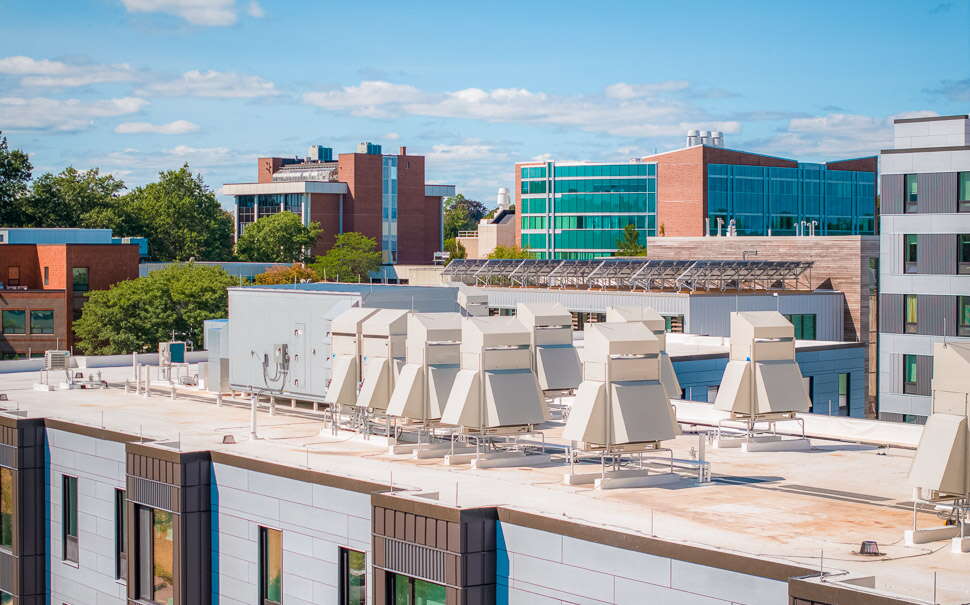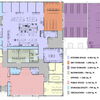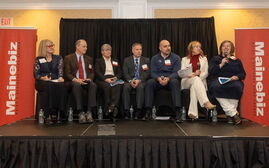
Processing Your Payment
Please do not leave this page until complete. This can take a few moments.
- News
-
Editions
View Digital Editions
Biweekly Issues
- December 1, 2025
- Nov. 17, 2025
- November 03, 2025
- October 20, 2025
- October 6, 2025
- September 22, 2025
- + More
Special Editions
- Lists
- Viewpoints
-
Our Events
Event Info
Award Honorees
- Calendar
- Biz Marketplace
Pumped up on heat pumps: Maine leads the nation on installations
 Photo / Tim Greenway
Ryan Keith of Northeast Heat Pumps says the technology pretty much sells itself these days.
Photo / Tim Greenway
Ryan Keith of Northeast Heat Pumps says the technology pretty much sells itself these days.
In 2008, Ryan Keith started learning about air-source heat pump systems, at a time when the energy- and cost-efficient heating, air conditioning and dehumidification technology was still little-known in Maine.
Keith took classes and watched a step-by-step video to learn how to install a heat pump in his own home.
“It knocked my oil bill down 50% to 60% in the first year,” he recalls. “The cooling aspect was almost just as amazing.”
He installed heat pumps for other family members; the same results gave him confidence to start pitching to customers through his new company, Northeast Heat Pumps in Brunswick.
“It was still new in Maine and people were nervous installing them,” he says.
Things soon changed. The first year, Keith installed units in two or three houses. Today he has 25 employees who install about 1,200 units per year — on average two units per home. Sixty percent are retrofits for customers looking to switch from fossil fuels. Installations can be done incrementally, with rebates and tax credits along the way.
Keith is one of Maine’s top heat pump installers based on the number of Efficiency Maine rebate eligible installations, including residential retrofit, new-construction and commercial projects. His company specializes in wall-mounted heat pump systems and has an in-house training facility for new hires.
“Heat pumps sell themselves,” says Keith. “I haven’t had to advertise much. It’s all literally word of mouth.”
Broad adoption
Air-source heat pumps are gaining traction in Maine. In 2019, Gov. Janet Mills set a goal to install 100,000 units — in homes, businesses and public buildings — by 2025, along with enhanced rebates through Efficiency Maine and a low-income heat pump program at MaineHousing.
The target was exceeded two years early with 104,000 installations. About half of the goal to install 15,000 heat pumps in low-income households by 2025 was reached by November 2023.
The state’s new target is 175,000 more heat pumps by 2027. If achieved, Maine would have over 320,000 heat pumps in total.
Following the 2109 announcement, the Maine Community College System expanded its heat pump workforce programs with added training lab space, instructors, short-term training programs and heat pump training units in its degree and certificate programs. The system has since trained hundreds of heat pump technicians.
Efficiency Maine Trust data show the technology has broad adoption in rural and northern Maine. As of 2021, heat pumps were more common than oil heat in new homes, according to a 2021 Maine New Construction Baseline Assessment. They are the most popular heating system across all of Efficiency Maine’s rebates.

“You have to be impressed with what Maine’s community of heat pump installers have accomplished in our state,” says Michael Stoddard, executive director of Efficiency Maine.
“Their adept marketing and skilled installations make them the perfect partners for the incentive programs that the governor and legislature have funded through Efficiency Maine’s programs, and together we are changing how Mainers heat and cool their buildings.”
Enhanced incentives
Heat pumps transfer heat extracted from the outdoor air or from the constant temperature of the ground below the frost line. They also work for cooling, ventilation and dehumidification.
They come in various configurations.
Air-source heat pumps include an outdoor condenser and indoor heads, with simple through-wall connections or ductwork. There are split versus package systems, multi-zone versus single-zone, rooftop units, variable refrigerant flow systems that condition large spaces with fewer outdoor units and geothermal water source systems.
According to the U.S. Department of Energy, air-source heat pumps have been used for many years in nearly all parts of the U.S., except in areas with extended periods of subfreezing temperatures.
In recent years, the technology advanced and now works in colder regions. Enhanced financial incentives are attracting more takers.
For Maine homeowners, rebates range from $4,000 to $8,000 depending on income. There’s a 30% federal tax credit up to $2,600.
For example, a moderate-income homeowner can receive a $6,000 rebate and a $2,000 tax credit. If she pays $13,800 for three units, her final tab would be $5,800.
The annual savings compared with oil heat could be $905 with a 6.4-year payback period.
On the commercial side, Efficiency Maine offers an array of initiatives and financial incentives based on type of system and type of project, along with certain sectors.
The market trajectory over the past six years has been significant, from 8,818 units installed in 2018 to 32,335 in 2023. Most are retrofits. A survey shows that 37% of newly built homes in Maine have at least one heat pump; 20% of those exclusively use heat pumps.
“If they weren’t working, word wouldn’t be getting out,” Stoddard says.
Leading the nation
Efficiency Maine recently redesigned its incentive program to optimize rebates and tax credits in order to encourage consumers to shift entirely to heat pumps.
From a couple of million dollars 10 years ago, the rebate program has $26 million available this year. “This is very high priority,” Stoddard says.

Consumers are noticing. “We are leading the nation in installing heat pumps,” says Stoddard.
“That’s a testament to the excellent work of the contractors in Maine, who go into communities and market the advantages of heat pumps and do a good job of installing and servicing them, as well as to the savvy of consumers, who make an effort to keep themselves informed about different types of technologies, different fuels and what they cost. And they like what they see when they see heat pumps.”
Accordingly, the industry is growing as existing HVAC companies switch to or add the product and new companies come online, many offering on–the-job training or collaborating with manufacturers and higher education. Efficiency Maine provides scholarships for community college courses.
Over 500 heat pump installers are registered with Efficiency Maine — far more than many other states, says Stoddard.
Josh Tucker, owner of Valley Home Services in Hermon, is another top installer, with nearly 40 employees and two locations. Like Keith, Tucker took heat pump classes in 2012 and tested his skills on a family member.
“My sister was building a house and she was our first customer,” he says. The first year, he averaged two or three units per week. Last year, it was 70 to 80. “People love them,” he says.
Commercial growth
About half of Avesta Housing’s properties utilize heat pump technology of some form, according to Todd Rothstein, the nonprofit’s director of construction.

The installation of “packaged” units at its recently completed Porter Station affordable housing development in Portland required diligence throughout the design process “to make sure things were appropriately sized, that we had the right ventilation and outputs, and more,” says Avesta’s senior development officer, Catherine Elliott.
She continues, “One challenge was that the packaged units have a couple of building penetrations for each one and therefore lose a fair amount of air through the building envelope; this makes it harder to get a good blower door test result.
"We had to do a lot of extra testing and air sealing around the units to ensure we still hit the necessary building performance thresholds.”
Exponential increase
At SMRT Architects & Engineers in Portland, installations have increased exponentially in sync with manufacturers expanding their product offerings, says Kate Everett, a senior principal and mechanical engineer.
Roughly two-thirds of SMRT’s projects are designed using some form of heat pump. That includes commercial solutions such as variable refrigerant flow systems that can connect to more indoor distribution systems to condition large spaces with fewer outdoor units, along with water source or geothermal heat pumps that use the constant temperature of the ground below the frost line, and heat pump water heaters.
SMRT used a variable refrigerant flow system at Portland Commons, the new University of Southern Maine residence hall, expected to use approximately 50% less energy than it would if it met minimum energy code requirements in force at the time of design.
The project received approximately $480,000 in financial incentives from Efficiency Maine’s commercial and industrial incentive program.

“VRF is a highly efficient ductless air source heat pump system that heats and cools using piped refrigerant as opposed to air ducts,” says Everett.
“These are similar to the residential style heat pump units that many of us have installed in our homes over the last several years, but these are larger scale systems connected to multiple indoor units. Depending on the space they serve, many of the indoor units allow simultaneous heating and cooling, which increases the user control and comfort on a large scale installation such as this.”
The project aligned with USM’s goal to be carbon neutral by 2040, and Maine’s Climate Action Plan’s goal to reduce greenhouse gas emissions by 45% by 2030, Everett notes.
Additionally, “VRF systems don’t need a lot of space to install compared to traditional equipment, so it actually allowed us to have a lower floor-to-floor height in the building,” she says. “That reduced the overall size of the building we constructed, and the associated volume that had to be heated and cooled, leading to both first cost and life cycle cost savings.”
A hybrid first
SMRT is designing a new project in Falmouth that will use a hybrid VRF system — the newest evolution designed to maintain VRF benefits while minimizing the need for refrigerant leak detection in occupied spaces.

“SMRT’s project will be the first one in the state of Maine to utilize this system,” says Everett.
Ellen Belknap, a senior principal at SMRT, says commercial systems are coming into common use. “They are no longer an emerging technology,” says Belknap. “They’re no longer considered alternative and they are widely accepted because it’s such a net positive to the environment. The huge win is that they’re powered by electricity and that allows us to get off of fossil fuel.”
Belknap credits Efficiency Maine for the state’s progress. “They’ve done an exemplary job in the deployment and education and incentives around heat pumps,” she says. “Maine is an early adopter state, and that’s a great place to be. I feel Efficiency Maine under Michael Stoddard’s leadership has gone the extra mile to get that uptake on heat pumps.”
Holistic next chapter
Says Stoddard, “We’ve had a terrific run for the past 10 years, getting this new technology on its feet and the industry around it to make this new technology successful, and to make sure people are aware of what a great economic opportunity it is.
"Now we’re entering a new chapter where we need to focus on transitioning entire buildings to this new technology. We’re not just going to do onesies and twosies anymore. We need to take a holistic approach. That’s the exciting new chapter for the next 10 years.”
Mainebiz web partners
Related Content

The Giving Guide
The Giving Guide helps nonprofits have the opportunity to showcase and differentiate their organizations so that businesses better understand how they can contribute to a nonprofit’s mission and work.
Learn More
Work for ME
Work for ME is a workforce development tool to help Maine’s employers target Maine’s emerging workforce. Work for ME highlights each industry, its impact on Maine’s economy, the jobs available to entry-level workers, the training and education needed to get a career started.
Learn More
Groundbreaking Maine
Whether you’re a developer, financer, architect, or industry enthusiast, Groundbreaking Maine is crafted to be your go-to source for valuable insights in Maine’s real estate and construction community.
Learn more-
The Giving Guide
The Giving Guide helps nonprofits have the opportunity to showcase and differentiate their organizations so that businesses better understand how they can contribute to a nonprofit’s mission and work.
-
Work for ME
Work for ME is a workforce development tool to help Maine’s employers target Maine’s emerging workforce. Work for ME highlights each industry, its impact on Maine’s economy, the jobs available to entry-level workers, the training and education needed to get a career started.
-
Groundbreaking Maine
Whether you’re a developer, financer, architect, or industry enthusiast, Groundbreaking Maine is crafted to be your go-to source for valuable insights in Maine’s real estate and construction community.
ABOUT
NEW ENGLAND BUSINESS MEDIA SITES
No articles left
Get access now
In order to use this feature, we need some information from you. You can also login or register for a free account.
By clicking submit you are agreeing to our cookie usage and Privacy Policy
Already have an account? Login
Already have an account? Login
Want to create an account? Register
Get access now
In order to use this feature, we need some information from you. You can also login or register for a free account.
By clicking submit you are agreeing to our cookie usage and Privacy Policy
Already have an account? Login
Already have an account? Login
Want to create an account? Register











0 Comments